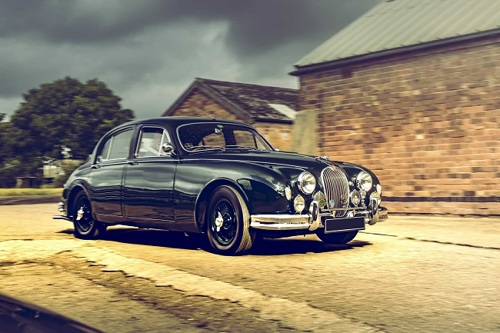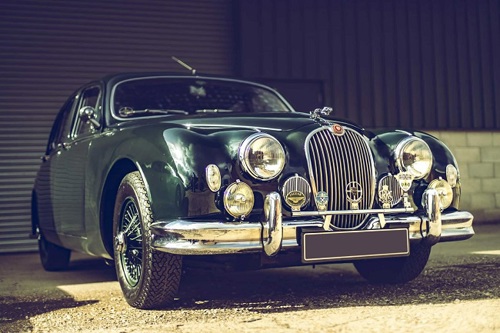MEET THE OWNER – ANDREW BADHAM AND HIS JAGUAR 3.4 MK.1
23 December 2024
“I was looking for a really good Mike Hawthorn Mk.1 for a long time at the beginning of Covid. I found her on M&C Wilkinson’s Sayer Selection website. They had looked after the car since 2015 for the previous owner and completed lots of upgrade work after the full restoration, i.e., power lock diff, Koni adjustable shocks, a five-speed box and power steering. The other big plus was that the car had a very rare factory-fitted steel sunroof!”

Andrew Badham is the proud owner of a last-of-the-line 1959 Jaguar 3.4 Mk. 1, a car with virtually no rivals when it was new. Neither the Riley Two Point Six nor the Rover P5 3-Litre, fine cars though they were, could offer such performance, for the 3.4 combined the handling of an open two-seater with room for five. Here was the ideal transport for Goodwood, with one of the most glorious engine notes in motoring history.
Jaguar began work on ‘Project Utah’, their five-seater monocoque bodied sports saloon, in 1952. They unveiled the 2.4 saloon in October 1955 at the London Motor Show. The top speed was 101 mph, impressive by mid-1950s standards, but many enthusiasts craved more performance. In addition, Jaguar’s US customers wanted more acceleration than 0-60 in 15 seconds.

Therefore, Browns Lane decided to offer a 3.4-litre unit from the XK140 with a B-Type cylinder head. The 3.4 Mk.1, as the first-generation compact Jaguar saloons became retrospectively known, could be distinguished from the 2.4 via its cutaway rear spats and a larger front grille. In the winter of 1957, the company dispatched 200 models to the States for evaluation shortly before the 3.4’s projected launch in February. On the 12th of that month, a fire ravaged the plant, but thanks to the workforce, production resumed within six weeks.
Sales were initially for export only, and when the 3.4 was available in the UK by late 1957, the price was £1,672 7s. This was a considerable sum – more than twice the cost of a Ford Consul Mk.2 - but few well-heeled drivers could resist the 120-mph top speed, 0-60 in just over nine seconds and a 210 bhp output. Autocar described the 3.4 as “both outright and in terms of value for money as one of the most outstanding cars in current production anywhere”. Motor Sport found it an: "impressive “business-man’s express.” The seemingly unlimited supply of power which pours from the outstandingly smooth and quiet twin-cam engine".

The most famous 3.4 driver was Mike Hawthorn, who raced it at the 1957 and 1958 Daily Express International Trophy meetings. VDU 881 featured a Tourist Trophy garage exhaust system, a competition clutch, Marchal headlights, Mintex brake pads, competition clutch, high-compression pistons, wider rear wheels and modified suspension. There was also a 160-mph speedometer.
The Mk.2 replaced the Mk.1 in 1959, and Andrew says of his 3.4:
“The previous owner toured my car quite extensively after buying it at auction in 2014, and at that time, it was the most expensive Mk.1 to sell at auction at £28,000. He then spent £50k on mods and upgrades, making it better to drive with the Wilkinson’s - I have all this documented in the service history. The car went by boat to the USA across three states and queued through Death Valley! So, I bought a well-restored proven car.”
As for the Jaguar’s road manners: “She drives really well, cruises at 70-80mph and the stainless exhaust makes a lovely noise!”. Sharp-eyed readers will also notice the triangular badge on the rear bumper. The early 3.4s had all-drum brakes that proved utterly inadequate, so discs became a £36 15s option when UK sales commenced. Virtually no customers ordered the cheaper set-up, while the red warning triangle badge alerted other drivers to the Jaguar’s stopping power.
And above all, Andrew’s 3.4 Mk.1 more than lives up to the brochure’s promise of having “the unmistakable line of grace”.
With thanks to Andrew Badham for his time and permission to use the images in this blog.
